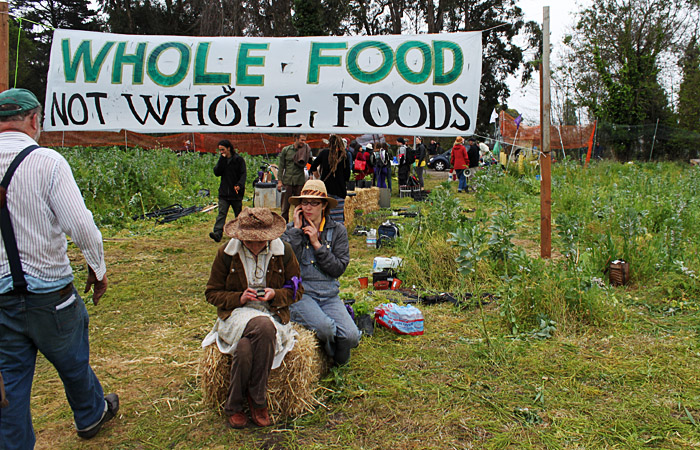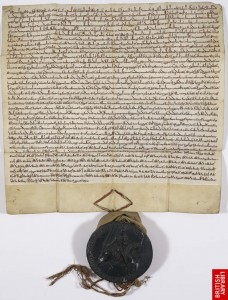Yesterday, I talked with friends about whether it might be possible to do for climate and food justice what David Graeber and others like Occupy Student Debt have done so powerfully with debt–transform it from a guilt-inducing issue to a mobilizing one. In Debt Graeber both refuses to accept that the modern has priority and more simply still talks about a one-word term that has resonance for all of us.
As I write a major university is evicting people who wanted to farm disused land: and I wondered if land might be that word for the set of issues around food, climate, animals, and so on? This is just the beginnings of an idea but here’s my train of thought, FWIW.
Quick background: in Albany, CA, Occupy the Farm took over some land owned by the University of California at Berkeley on Earth Day (April 22) and began to cultivate it as a local farm. Although you might want to see the name as a shortening of “occupy this land in order to make a farm.”
Lesley Haddock, one of the occupiers, specifies:
Since taking over this land, the university has chopped up the original 104-acre plot and sold piece after piece to be developed. Now only 10 acres remain. That remaining plot has been transferred from the College of Natural Resources to U.C. Berkeley Capital Projects, the branch of the university responsible for securing development plans. Five of the remaining acres are already fated to be paved over for a high-end senior complex.
The occupiers have cleared and tilled the land and planted thousands of pre-prepared seedlings on about five acres of the plot. It’s a really beautiful action. The University is using the law and the police to get them out.
It’s easy to see that there is a direct link from debt to land here. UC needs to raise money because the state has cut its funding due to the Republican refusal to raise any form of taxation. Tuition is about as high as it can go, so the privatizing logic goes that it’s time to asset strip.
The land at Gill Tract happens to be Class One soil, perfect for farming. To put that in perspective, compare the urban farmers in Brooklyn, many of whom have to cultivate in planters because the soil is too contaminated, or plant sunflowers to help clean the soil of heavy metals. Even so, such land sells for about $180,000 a square foot, according to the NY Times. While the buildings that UC wants to create could in theory go anywhere, and good urban farmland like this is very scarce, it becomes highly valuable when it converts from land to “real estate.” One rumor has it that there are plans to build a Whole Foods on the site.
Now the cycle of escalating force has begun. First the UC police turned off the water. Today they locked the fence, so people are passing water and food for occupier/farmers over the fence.
All this reminded me Hardt and Negri’s reference to the Charter of the Forest in Peter Linebaugh’s Magna Carta Manifesto. So I looked it up and it is very intriguing. Magna Carta is so known because it was linked in 1217 to the Charter of the Forest. According to the British Library,
The Charter of the Forest restored the traditional rights of the people, where the land had once been held in common, and restrained landowners from inflicting harsh punishments on them. It granted free men access to the forest (though at this time only about 10 per cent of the population was free).
Free men could enjoy such rights as pannage (pasture for their pigs), estover (collecting firewood), agistment (grazing), or turbary (cutting of turf for fuel).
As Linebaugh puts it, the Charter defined the limits to the privatization of the commons. Against the conservative view of the commons as a disaster waiting to happen (because everyone would use them to the maximum), he cites a definition from 1598 that stresses that the common is
a Communitate, of communitie, participation or fellowship.
You might begin to think about this defense of (limited) rights as defining a long period of land use rights from the eleventh century to the eighteenth in which there were two notable attempts to scale them back
The first was back by King John, leading to the Charters of 1217 and then King Charles attempted to revive and extend his feudal rights in the 1630s, leading to the English Revolution. The Diggers and other radicals claimed that they were defending “Anglo-Saxon liberties” against tyranny and you could see the 1649 Digger slogan “the earth a common treasury for all” as being in the spirit of the Charter.
The Marxist historian Christopher Hill used to suggest that when the Diggers called for people to abstain from waged labor and instead till the common land, it was a call for a general strike. There were explicit calls for workers to take “holidays” during the English Commonwealth (1649-1660) that led to the Chartist call for a Grand National Holiday, or general strike, in 1839. Enclosure–the private occupation of common lands– has long been understood as a key moment in the agricultural and industrial revolutions alike. The larger farms produced more food, while the displaced tenants became factory workers.
So it’s perhaps less surprising than it might seem that during the 1999 global justice protests in London, banners were again seen with “the earth a common treasury for all.” Perhaps where the Earth, the global, the environment, ecology and so on have failed to become real abstractions that motivate social movements, land might do it. Just a thought.




Pingback: Sunday Reading « zunguzungu